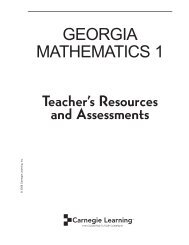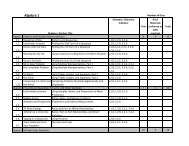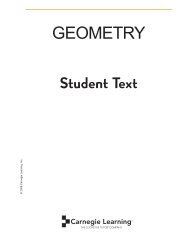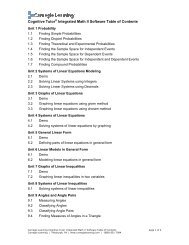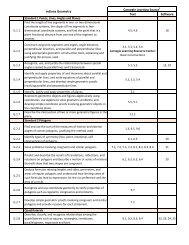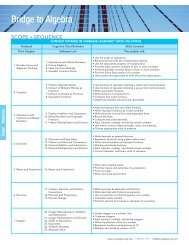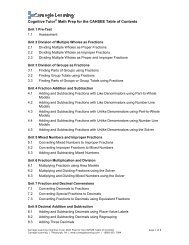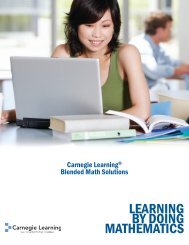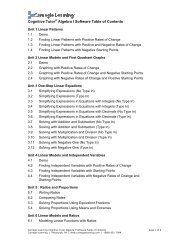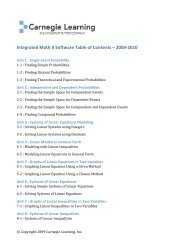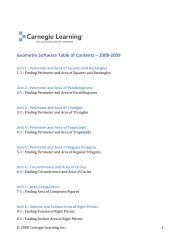1 of 5 - Carnegie Learning
1 of 5 - Carnegie Learning
1 of 5 - Carnegie Learning
Create successful ePaper yourself
Turn your PDF publications into a flip-book with our unique Google optimized e-Paper software.
<strong>Carnegie</strong> <strong>Learning</strong> Algebra 1 Correlations to Utah's Algebra 1<br />
Textbook<br />
Chatper<br />
S<strong>of</strong>tware<br />
Unit<br />
Standard 1<br />
Students will expand number sense to understand, perform operations, and solve problems with real numbers.<br />
a) Define a rational number as a<br />
point on the number line that can<br />
be expressed as the ratio <strong>of</strong> two<br />
integers, and points that cannot<br />
be so expressed as irrational.<br />
2, 3, 4 7, 8, 16<br />
Objective 1<br />
Represent real numbers as points on the number line and<br />
distinguish rational numbers from irrational numbers.<br />
b) Classify numbers as rational or<br />
irrational, knowing that rational<br />
numbers can be expressed as<br />
terminating or repeating decimals<br />
and irrational numbers can be<br />
expressed as non-terminating,<br />
non-repeating decimals.<br />
4 16<br />
c) Classify pi and square roots <strong>of</strong><br />
non-perfect square numbers as<br />
irrational.<br />
4, 8 16<br />
d) Place rational and irrational<br />
numbers on a number line<br />
between two integers.<br />
3, 4 16<br />
a) Simplify, add, subtract,<br />
multiply, and divide expressions<br />
with square roots.<br />
8, 9<br />
Objective 2<br />
Compute fluently and make reasonable estimates with rational<br />
and irrational numbers.<br />
b) Evaluate and simplify<br />
numerical expressions containing<br />
rational numbers and square<br />
roots using the order <strong>of</strong><br />
operations.<br />
1-13<br />
1-6, 8, 10,<br />
14, 15, 16,<br />
18, 19, 20,<br />
21, 22, 23,<br />
26, 27, 35,<br />
36, 37, 12,<br />
41, 34, 44,<br />
14, 19, 17<br />
1 <strong>of</strong> 5
<strong>Carnegie</strong> <strong>Learning</strong> Algebra 1 Correlations to Utah's Algebra 1<br />
Textbook<br />
Chatper<br />
S<strong>of</strong>tware<br />
Unit<br />
Objective 2<br />
Compute fluently and make reasonable estimates with rational<br />
and irrational numbers.<br />
c) Compute solutions to<br />
problems, represent answers in<br />
exact form, and determine the<br />
reasonableness <strong>of</strong> answers.<br />
d) Calculate the measures <strong>of</strong> the<br />
sides <strong>of</strong> a right triangle using the<br />
Pythagorean Theorem.<br />
13 41, 42<br />
Standard 2<br />
Students will extend concepts <strong>of</strong> proportion to represent and analyze linear relations.<br />
Objective 1 Represent and analyze the slope <strong>of</strong> a line.<br />
a) Identify the slope <strong>of</strong> a line<br />
when given points, a graph, or an<br />
equation.<br />
b) Identify horizontal and vertical<br />
lines given the equations or<br />
slopes.<br />
c) Determine the effect <strong>of</strong><br />
changes in slope or y-intercept in<br />
y = mx + b.<br />
5 10, 18, 21, 22<br />
5 10, 18, 21, 22<br />
5, 8 10, 18, 21, 22<br />
d) Determine and explain the<br />
meaning <strong>of</strong> slopes and intercepts<br />
using real-world examples.<br />
a) Write algebraic expressions or<br />
equations to generalize visual<br />
patterns, numerical patterns,<br />
relations, data sets, or scatter<br />
plots.<br />
5, 8<br />
1, 6,<br />
10, 18, 21,<br />
22, 26, 27<br />
1, 3, 6, 10,<br />
15, 18, 21<br />
Objective 2<br />
Model and interpret problems having a constant rate <strong>of</strong> change<br />
using linear functions.<br />
b) Represent linear equations in<br />
slope-intercept form, y = mx + b,<br />
and standard form, Ax+ By =C.<br />
5 18, 21, 22<br />
c) Distinguish between linear and<br />
non-linear functions by examining<br />
a table, equation, or graph.<br />
1, 2, 4, 5, 8 18, 23<br />
2 <strong>of</strong> 5
Objective 3<br />
<strong>Carnegie</strong> <strong>Learning</strong> Algebra 1 Correlations to Utah's Algebra 1<br />
Represent and analyze linear relationships using algebraic<br />
equations, expressions, and graphs.<br />
d) Interpret the slope <strong>of</strong> a linear<br />
function as a rate <strong>of</strong> change in<br />
real-world situations.<br />
a) Write the equation <strong>of</strong> a line<br />
when given two points or the<br />
slope and a point on the line.<br />
b) Approximate the equation <strong>of</strong> a<br />
line given the graph <strong>of</strong> a line.<br />
c) Identify the x- and y-intercepts<br />
from an equation or graph <strong>of</strong> a<br />
line or a table <strong>of</strong> values.<br />
Textbook<br />
Chatper<br />
S<strong>of</strong>tware<br />
Unit<br />
5, 8 10, 18, 21, 22<br />
5 10, 18, 21, 22<br />
1, 4,5, 8 18, 21, 22<br />
d) Graph linear relations and<br />
inequalities by plotting points, by<br />
finding x- and y-intercepts, or by<br />
using the slope and any point on<br />
the line.<br />
3, 4, 5, 7,<br />
8,<br />
3, 10, 12, 18,<br />
21, 22, 26<br />
Standard 3<br />
Students will develop fluency with the language and operations <strong>of</strong> algebra to analyze and represent relationships.<br />
a) Simplify and evaluate<br />
monomial expressions and<br />
formulas.<br />
10<br />
3, 4, 10, 33,<br />
34, 35, 36<br />
Objective 1<br />
Simplify polynomials and the quotient <strong>of</strong> monomials.<br />
b) Add and subtract polynomials. 10 35, 36<br />
c) Multiply monomials by a<br />
polynomial.<br />
10 35, 36<br />
d) Multiply binomials. 10 35, 36<br />
e) Simplify the quotient <strong>of</strong><br />
monomials using positive<br />
exponents.<br />
9, 10 33, 34, 35, 36<br />
3 <strong>of</strong> 5
Objective 2<br />
<strong>Carnegie</strong> <strong>Learning</strong> Algebra 1 Correlations to Utah's Algebra 1<br />
Solve and interpret linear equations and inequalities in various<br />
situations including real-world problems.<br />
a) Solve single-variable linear<br />
equations and inequalities<br />
algebraically and graphically.<br />
b) Solve real-world problems<br />
involving constant rates <strong>of</strong><br />
change.<br />
c) Solve equations for a specified<br />
variable.<br />
Textbook<br />
Chatper<br />
1-13<br />
1, 5, 8<br />
1<br />
S<strong>of</strong>tware<br />
Unit<br />
throughout<br />
sw<br />
1, 3, 6, 10,<br />
15, 16, 18,<br />
21, 22<br />
4, 5, 11, 14,<br />
15, 19, 20, 22<br />
d) Solve proportions that include<br />
algebraic first-degree<br />
expressions.<br />
a) Solve systems <strong>of</strong> two linear<br />
equations graphically and<br />
algebraically with and without<br />
technology.<br />
7 21, 23, 27<br />
Objective 3<br />
Solve and interpret pairs <strong>of</strong> linear equations and inequalities.<br />
b) Determine the number <strong>of</strong><br />
possible solutions for a system <strong>of</strong><br />
two linear equations.<br />
7 21, 23, 27<br />
c) Graph a system <strong>of</strong> linear<br />
inequalities and identify the<br />
solution.<br />
4, 7 22, 26, 27, 12<br />
a) Find the greatest common<br />
monomial factor <strong>of</strong> a polynomial.<br />
4, 10 14, 15, 35, 36<br />
Objective 4<br />
Factor polynomials with common monomial factors and factor<br />
simple quadratic expressions.<br />
b) Factor trinomials with integer<br />
coefficients <strong>of</strong> the form x² + bx +<br />
c.<br />
c) Factor the difference <strong>of</strong> two<br />
squares and perfect square<br />
trinomials.<br />
10 35, 36, 37<br />
13 36, 37<br />
4 <strong>of</strong> 5
<strong>Carnegie</strong> <strong>Learning</strong> Algebra 1 Correlations to Utah's Algebra 1<br />
Textbook<br />
Chatper<br />
S<strong>of</strong>tware<br />
Unit<br />
Objective 5<br />
Solve quadratic equations using factoring or by taking square<br />
roots.<br />
a) Solve quadratic equations that<br />
can be simplified to the form x² =<br />
a where a is greater than or equal<br />
to 0 by taking square roots.<br />
b) Solve quadratic equations<br />
using factoring.<br />
c) Write a quadratic equation<br />
when given the solutions.<br />
8, 13 43<br />
8, 13<br />
28, 29, 30,<br />
36, 37, 43<br />
8, 13 28, 29, 30, 43<br />
Standard 4<br />
Students will understand concepts from statistics and apply statistical methods to solve problems.<br />
Objective 1<br />
Objective 2<br />
Summarize, display, and analyze bivariate data.<br />
Estimate, interpret, and use lines fit to bivariate data.<br />
a) Collect, record, organize, and<br />
display a set <strong>of</strong> data with at least<br />
two variables.<br />
b) Determine whether the<br />
relationship between two<br />
variables is approximately linear<br />
or non-linear by examination <strong>of</strong> a<br />
scatter plot.<br />
c) Characterize the relationship<br />
between two linear related<br />
variables as having positive,<br />
negative, or approximately zero<br />
correlation.<br />
a) Estimate the equation <strong>of</strong> a line<br />
<strong>of</strong> best fit to make and test<br />
conjectures.<br />
b) Interpret the slope and y-<br />
intercept <strong>of</strong> a line through data.<br />
c) Predict y-values for given x-<br />
values when appropriate using a<br />
line fitted to bivariate numerical<br />
data.<br />
1<br />
6<br />
6<br />
5, 8 10, 18, 21, 22<br />
5 <strong>of</strong> 5




